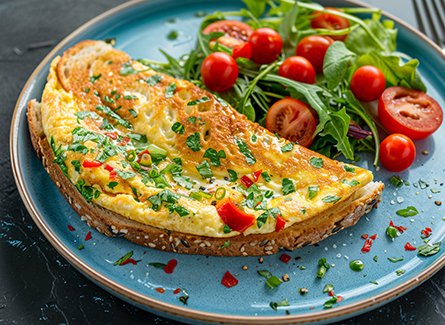
Move over, vegetable oil. A new crowd of cooking oils is taking over the kitchen. Cooks love flirting with these subtle and smooth oils that offer both flavorful flair and heart healthy benefits.
First Things First
When you hear the terms “healthier” fats or “good” fats, they’re referring to monounsaturated and polyunsaturated fats. These fats are better for your heart than “bad” fats, which include saturated fats (think: butter, lard and shortening).
To keep your heart healthy, the American Heart Association recommends choosing oils with less than 4 grams of saturated fat per tablespoon, and no partially hydrogenated or trans fats. Consistently eating foods with bad fats can cause high cholesterol, which leads to heart disease.
On With the Show
At first glance, the oil aisle at the grocery store can be a little intimidating. Some shoppers stroll in with the confidence of a celebrity cook, only to stare slack-jawed at the choices. Overwhelmed, the bottle of canola (not a bad choice) wins. But, no more! We give you the who, what, when, where, why and how of healthy cooking oils.
Who, What and Why
- Avocado. This oil is the newbie in the group. It has just 1.6 grams of saturated fat per tablespoon and is high in monounsaturated fats. It has a neutral taste, meaning it doesn’t add much flavor. However, avocado oil tends to be more expensive than other options because it’s not chemically processed.
- Canola. At least when we choose desperately, we choose wisely. Canola oil is low in saturated fat and a great choice for roasting and baking. Like avocado oil, it has a neutral taste.
- Coconut. Coconut oil, while high in saturated fat, is better for you than butter because of the way your body metabolizes it. Enjoy it — and the flavor it imparts — in moderation.
- Corn. Corn oil can lower blood pressure and LDL cholesterol (bad) levels. It has both polyunsaturated and monounsaturated fatty acids.
- Extra virgin olive oil. EVOO is so cool, it goes by initials only. It's higher quality than regular olive oil, has a more intense olive taste and is unrefined. It’s also high in monounsaturated fats and omega-3 fats. Research studies suggest it can lower your blood pressure when your heart relaxes (aka diastolic blood pressure, or “the bottom number” in your blood pressure reading.)
- Olive. Olive oil, the most popular oil in the pack, adds just a hint of flavor. It’s certainly a healthy choice, with omega-3 and omegag-6 fats. Although it’s refined, when it comes to cooking foods at a high temperature, it’s better than EVOO, which burns more easily.
- Peanut. If you want your food to have nutty appeal, this is your oil. It’s low in saturated fat and packed with flavor.
Where, When and How
Our brains have a funny way of translating the words “cooking oil,” into “eat fried foods.” The oils listed here, and others we didn’t cover, are great for sautéing, roasting, baking and drizzling, which are all healthier ways to prepare food. Indulge in fried foods on limited and special occasions.
Overall, keep in mind that moderation is what counts when it comes to cooking oils, even the ones considered heart healthy.
Read more about women’s specific nutrition needs, opens new tab.
Related Articles

November 6, 2024
10000 Steps Good Enough
How many steps did you log today? It’s a popular question, and the gold standard answer is 10,000. Yet, depending on your health goals, you may need to pick up the pace.

May 31, 2019
5 Day Meal Prep
Who says eating healthy has to be difficult? One of our Registered Dietitians shows us how easy it can be to prep lunches for a busy week.

May 31, 2019
5 Foods With Health Benefits
Dark ChocolateBoost your mood and your memory (think antioxidants) by savoring dark chocolate. It may also help your heart health. Just 1 oz. is all it takes...

December 8, 2019
5 Free Indulgences
Are you ready for the hubbub of the holidays? The season’s festivities are always fun, but they can also wear you down. If your holiday spirit needs rechargi...

May 31, 2019
5 Minutes to a Happier You
Feeling stressed, angry or anxious? Head to the great outdoors. A new study has found that a five-minute walk can work wonders for your mood.The more natural...

July 26, 2022
5 Must Have Nutrients
Vitamins and minerals do a body good, but who has time to figure out which foods offer what benefits? This short list of five essential nutrients, opens new ...


